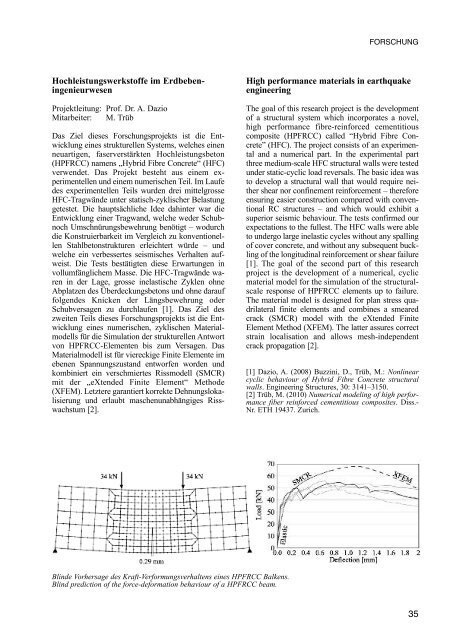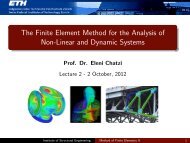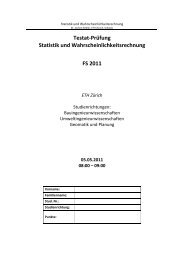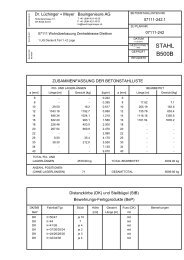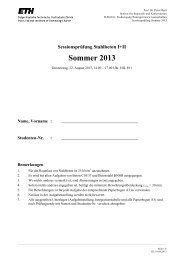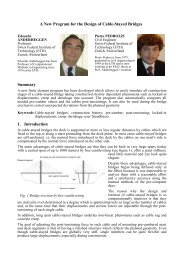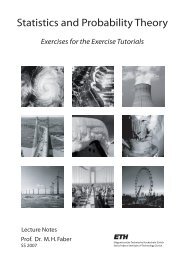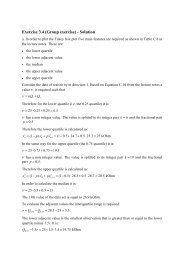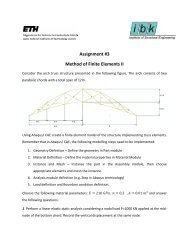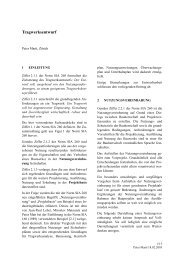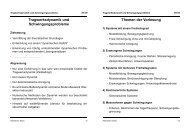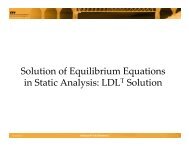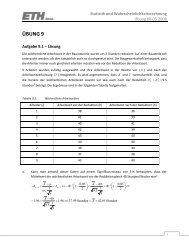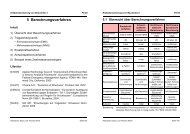JAHRESBERICHT - Institut für Baustatik und Konstruktion - ETH Zürich
JAHRESBERICHT - Institut für Baustatik und Konstruktion - ETH Zürich
JAHRESBERICHT - Institut für Baustatik und Konstruktion - ETH Zürich
Erfolgreiche ePaper selbst erstellen
Machen Sie aus Ihren PDF Publikationen ein blätterbares Flipbook mit unserer einzigartigen Google optimierten e-Paper Software.
FORSCHUNG<br />
Hochleistungswerkstoffe im Erdbeben -<br />
ingenieurwesen<br />
Projektleitung: Prof. Dr. A. Dazio<br />
Mitarbeiter: M. Trüb<br />
Das Ziel dieses Forschungsprojekts ist die Ent -<br />
wicklung eines strukturellen Systems, welches einen<br />
neuartigen, faserverstärkten Hoch leistungs be ton<br />
(HPFRCC) namens „Hybrid Fibre Concrete“ (HFC)<br />
verwendet. Das Projekt besteht aus einem ex -<br />
perimentellen <strong>und</strong> einem numerischen Teil. Im Laufe<br />
des experimentellen Teils wurden drei mittelgrosse<br />
HFC-Tragwände unter statisch-zyklischer Belastung<br />
getestet. Die hauptsächliche Idee dahinter war die<br />
Entwicklung einer Tragwand, welche weder Schubnoch<br />
Umschnürungsbewehrung be nötigt – wodurch<br />
die Konstruierbarkeit im Ver gleich zu konventionellen<br />
Stahlbetonstrukturen er leichtert würde – <strong>und</strong><br />
welche ein verbessertes seismisches Verhalten aufweist.<br />
Die Tests bestätigten diese Erwartungen in<br />
voll umfänglichem Masse. Die HFC-Tragwände wa -<br />
ren in der Lage, grosse inelastische Zyklen ohne<br />
Abplatzen des Überdeckungsbetons <strong>und</strong> ohne darauf<br />
folgendes Knicken der Längsbewehrung oder<br />
Schub versagen zu durchlaufen [1]. Das Ziel des<br />
zwei ten Teils dieses For schungs projekts ist die Ent -<br />
wick lung eines numerischen, zyklischen Ma te ri al -<br />
modells <strong>für</strong> die Si mu la tion der strukturellen Antwort<br />
von HPFRCC-Ele men ten bis zum Versagen. Das<br />
Materialmodell ist <strong>für</strong> viereckige Finite Elemente im<br />
ebenen Span nungs zustand entworfen worden <strong>und</strong><br />
kombiniert ein verschmiertes Rissmodell (SMCR)<br />
mit der „eXten ded Finite Element“ Methode<br />
(XFEM). Letztere garantiert korrekte Deh nungs lo ka -<br />
li sierung <strong>und</strong> erlaubt maschenunabhängiges Riss -<br />
wachs tum [2].<br />
High performance materials in earthquake<br />
engineering<br />
The goal of this research project is the development<br />
of a structural system which incorporates a novel,<br />
high performance fibre-reinforced cementitious<br />
composite (HPFRCC) called “Hybrid Fibre Con -<br />
crete” (HFC). The project consists of an experimental<br />
and a numerical part. In the experimental part<br />
three medium-scale HFC structural walls were tested<br />
<strong>und</strong>er static-cyclic load reversals. The basic idea was<br />
to develop a structural wall that would require nei -<br />
ther shear nor confinement reinforcement – therefore<br />
ensuring easier construction compared with conventional<br />
RC structures – and which would exhibit a<br />
superior seismic behaviour. The tests confirmed our<br />
expectations to the fullest. The HFC walls were able<br />
to <strong>und</strong>ergo large inelastic cycles with out any spalling<br />
of cover concrete, and without any subsequent buckling<br />
of the longitudinal reinforcement or shear fail ure<br />
[1]. The goal of the second part of this research<br />
project is the development of a numerical, cyclic<br />
material model for the simulation of the structuralscale<br />
response of HPFRCC elements up to failure.<br />
The material model is designed for plan stress quadrilateral<br />
finite elements and com bines a smeared<br />
crack (SMCR) model with the eXtended Finite<br />
Element Method (XFEM). The latter assures correct<br />
strain localisation and allows mesh-independent<br />
crack propagation [2].<br />
[1] Dazio, A. (2008) Buzzini, D., Trüb, M.: Nonlinear<br />
cyclic behaviour of Hybrid Fibre Concrete structural<br />
walls. Engineering Structures, 30: 3141–3150.<br />
[2] Trüb, M. (2010) Numerical modeling of high performance<br />
fiber reinforced cementitious composites. Diss.-<br />
Nr. <strong>ETH</strong> 19437. Zurich.<br />
Blinde Vorhersage des Kraft-Verformungsverhaltens eines HPFRCC Balkens.<br />
Blind prediction of the force-deformation behaviour of a HPFRCC beam.<br />
35


